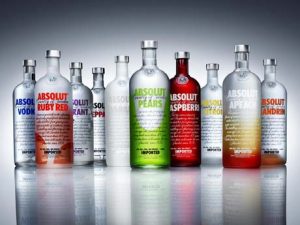Vodka
Spirit that can be distilled from any substance that presents starch or sugar. It is generally used cereal base or potato flour and pulp. It is considered as the traditional Russian and Polish alcoholic beverage, where the ideal rate of alcohol should be 38%, as indicated by the Russian chemist Dmitri Mendeleev. Vodka is now the most popular alcoholic beverage in the world and there are plenty of brands: for example, just Poland produces over a thousand different Vodkas. Highest consumption is registered in East Europe and in the Scandinavian countries, where Vodka has a centuries-old tradition, and in the U.S.A. and Western Europe, where its widespread use has relatively recent origins. The word "Vodka" derive from the contraction of the Slavic word "водичка" [vodichka] that is the diminutive of the corresponding English word "water". The first written appearance of this word came from Poland in 1405. In a Sandomierz Voivodato register (Sandomierz Voivodato was an administrative division and local government unit of the Kingdom of Poland from the fourteenth century, until the partition of Poland in 1772-1795 between the Russian Empire, the United Kingdom of Prussia and the House of Habsburgs of Austria) was found the name "little water", that p2016/02bly meant euphemistically a distillate light and clean in taste but certainly not in the alcohol volume. Vodka has also others names, all with the same root the means "burnt": in the Belarusian "Гарэлка" [Garelka]; in Polish "Gorzałka"; in Ukrainian "Горілка" [Gorilka]. In 1520 only in Gdansk, Poland, trhere were already sixty official distilleries, not counting the clandestine ones. In Russia the first document related to Vodka dates back to 1649 when Czar Alexei promulgated an imperial code for regulate the production permitting the noble landowners to hold a still for small productions for private consumption. In 1533 the name Vodka appeared in a medical prescription brought from Poland to Russia by a merchant from the zone of the ancient Kievan Rus', a medieval monarchy founded in the late ninth century in an area where today there are Ukraine, western Russia, Belarus, Poland, Lithuania, Latvia and eastern Estonia, considered the oldest East Slavic organized state, which has for a long time the capital in Kiev. Only on 8 June 1751 in a decree by Empress Catherine I, which regulated the ownership of some distilleries, the word Vodka was written by giving it the modern meaning. In the West Vodka became popular first in the U.S.A. where, in 1930, Vladimir Smirnoff took contact with Rudolph Kunett, a Russian immigrant whose family was the spirits supplier for Smirnoff before the October 1917 revolution, to organize the trade of Vodka in North America. In 1938 Kunett, not having the necessary funds to carry on the operation that did not seem profitable as it was thought, sold the rights of Smirnoff to John G. Martin, president of Heublein, a small American factory of spirits. It was the owner of Heublein to give Vodka the image it still keeps today. The entrepreneurial idea of Martin was to market a neutral spirit that would lend itself well to being mixed with other ingredients dissasociating significantly from the traditional Russian drink, with full character, served straight and ice-cold as an accompaniment to food. The advertising of the product emphasized the enormous versatility of this drink with clean and refined taste, in contrast with the stronger and full-bodied Bourbon, Gin and Whiskey. The idea of a pure and sophisticated distillate, that can give strength to the juices and sodas or to instil vitality and vigor in sweet liquors such as Vermouth, was an immediate success. In the 50s were launched slogans and posters focusing on the versatility of this distillate destined to become one of the spirits of the future in the world. A well-known image depicted an inviting cocktail, a result of the marriage between dry Martini and Vodka, with the imposing pyramid of Cheops in the background. Others exploited famous movie stars to publicize the drink. The tradition of associating Vodka to monuments and famous faces survived till today; for example, the Smirnoff portrayed near the colossal anthropomorphic statues of Easter Island or the Statue of Liberty. The message is clear: it is an international drink without time and space. Vodka, as mentioned, can be obtained from different raw materials rich of sugar or starch that allows the fermentation. Once fermented various distillations are carried out: this process brings the alcohol content and aroma level to the desired threshold. To delete unwanted notes the distillate is filtered to obtain a neutral product by using activated carbon or diamond dust, diatomaceous earth, etc. Sometimes, rather than to filter, it is possible to make a greater number of distillation to obtain an ethyl alcohol, which maintains also the characteristic aromas. After these processes the water is added, that may be rainwater, distilled or spring water, giving life to Vodka. Vodka is usually divided into two big categories: Vodka pure and aromatic. The used ingredients, therefore, are the factors that contribute most to give it the characteristic taste and aroma. To know the products from which it came it is essential to be able to appreciate it better: Cereals, rye is the grain traditionally used in the Vodka production, especially in Eastern Europe. In Russia, its use was almost exclusive until 1870, following the use of cereals and other plant such as potatoes became increasingly common, especially in time of economic crisis. Rye, of which Poland is the biggests producer, even if mixed with other grain in the first wort such as wheat, oats and barley, is the main ingredient of the best Russian Vodka with soft, sweet and delicate flavor and unique taste. Elsewhere, Wheat, cheaper and more popular, replaced rye. The best quality of wheat, from North America and Western Europe, decompose easily, allowing a rapid process of transformation of complex starches to fermentable sugars. These varieties allow to distillers to obtain high levels of purity, a highly desirable requirement; Potatoes, though considered an ingredient of the second category, are used for centuries in many eastern countries, like Ukraine. They have some disadvantages: they allow a lower yield than cereals, a tonne of potatoes gives 30% of Vodka less than the same quantity of wheat, the division into constituents is more difficult and, during the fermentation, are released waste products complicated to remove during the process of alcohol rectification. Vodka made from potatoes is heavier and has a stronger and more complex flavor than those made with wheat. Today, however, the progress in agriculture and distillation allows to obtain a good-quality Vodka, appreciated especially by those who like the strong flavors. Water, that constitutes 60% of the liquid contained in most of the bottles of Vodka, is softened by reducing dissolved salt content, it should contain less than 0.0042g of dissolved salts per 1.2l to be as pure as distilled water. This process is carried out directing it in deionizators and then pumping it through layers of sand or activated carbon to purify it further. In the past, in the absence of these techniques, the distilled water was used very much, although a produced Vodka was more opaque and with less bright flavor. The described stage is fundamental for the realization of a good Vodka since the addition of polluted or not perfectly pure water to a rectified distillate compromines its aroma and delicate flavor and roils the clear aspect: certain materials, such as iron, change color from contact with decayed water, altering the shade and doing the same with the distillate at which it is added.



